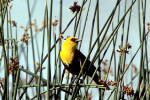"We believe we live in the best grass-fed beef producing area in the country. The cold summer nights and high soil mineral levels of our mountain pastures grows grass like nowhere else, and results in a uniquely flavorful beef."I'd thought, of course, about the effects of different feed inputs on the taste of beef, but I hadn't quite thought before about the effects of different soil and weather inputs on the flavor of grass, and how those in turn might subtly influence the meat's ultimate flavor.
Not only that, says rancher Glenn Elzinga, but "there are slight seasonal variations in the flavor balance due to a dynamic sward of grass and the various plant stages that define it at a particular point in the growing season."
The site has particularly good discussions of routine antibiotic use in the livestock industry, translating labels on meat, and how to cook grass-fed steaks.
From their page on environmental benefits, the Elzingas briefly describe their own efforts to improve the ecological working of their ranch:
"Water pollution from feedlot-raised beef is a growing concern. At Alderspring Ranch, we are careful about keeping the water that flows through our ranch clean. We have fenced cattle away from streams and riparian areas. We do everything we can to keep the valuable nutrients in cattle manure on our pastures rather than allowing it to escape and become water pollutants. We use a permaculture system of pasture maintenance. We do not plow and seed annual forages. We improve pastures through grazing management and hand seeding. This approach eliminates soil erosion, and works to build the organic matter and fertility of soil.You can read more about their production protocols here.
Finally, we avoid monocultures. We rejoice in our brushy fenced breaks that are home to deer, nesting birds and small mammals. We try to encourage the growth of cottonwoods along our ditches to supply shade for our cattle, and habitat for raptors that then reduce our rodent populations. We allow the wetter areas of our ranch to grow native sedge meadows, and graze these carefully to avoid hummocking."

3 comments:
I was very interested in this last posting, so much so that I wrote to Alderspring to order some steaks for a Christmas gift. When I lived in Seattle and started to eat grass-finished steaks, I didn't like them at all -- tasted like liver. I was used to corn-finished beef in Iowa -- see pen name. I'd like to give these Alderspring steaks a try. The photos show such a beautiful area that I can't imagine the steaks not being great, too.
Why did you change your pen name and what's it all about??
Hi there cornfed... see, this time I'm SURE who you are. :) I'm very happy to hear that I've given these friends-of-friends, who seem to be doing really good work, some business. I'm not much of a ordering-food-off-the-internet sort of person, but it did occur to me that this would be an excellent source for the whole Christmas-steak-type business and I'm glad you agree.
As for the pen name, I have just been having trouble with NOTHING I can think of being original. There's always somebody else with the same name. This is my third i.d. ("myeviltwin," "myothereviltwin," hence "third instar," which refers to larval stages of insects (most have a number of stages or instars). It comes up in the whole aquatic-invertebrate business and also seems appropriately metamorphic after a long absence...
Ah, yes, good name.
Post a Comment